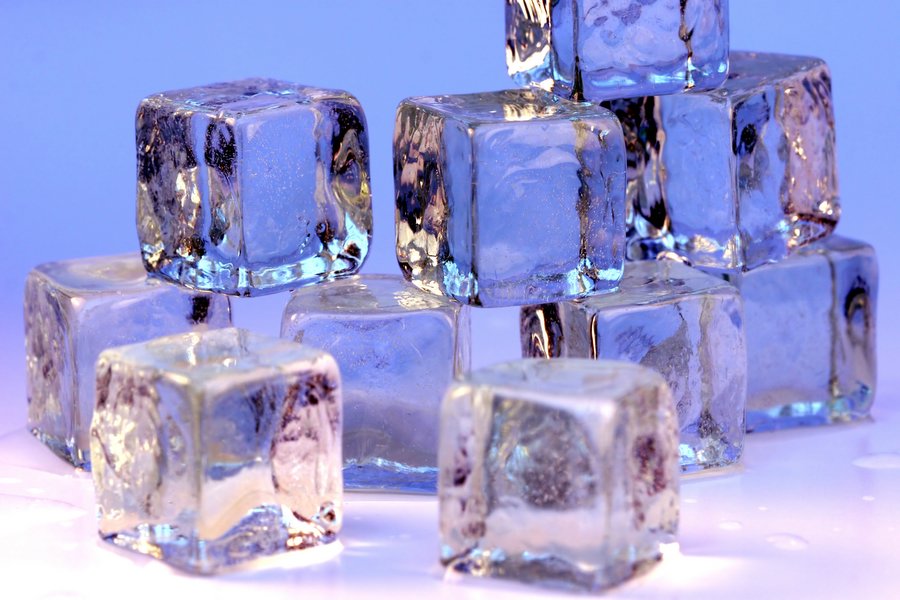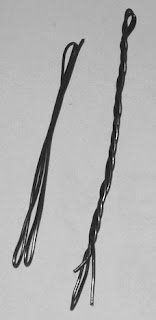You will notice that the resistance to snaps varies a lot in the several tests. Although they remain valid because I always compare in the same situations (from the same twisting lot, for example), that gave me the impression that the room temperature in different times of day have some influence too. So I twisted another 2 strands of wire cut it in half and putted one half in the fridge (5ºC) for an hour.
The results:
| Fridge | Around 20ºC | |
| 1º wire snaps | 110 | 90 |
| Additional bends | 40 | 30 |
| Total bends | 150 | 120 |
I don’t know why this lot lasted much more than the average, but the important thing is that, comparing the two halves, the one that has been in the fridge had a little more resistance to snaps (at least in such extreme temperature difference).
We can easily see that there are other factors more important and that controlling the set temperature is not easy, but this gives us another reason to always make cool movies.
Poderão notar que a resistência a quebras varia ao longo dos vários testes. Apesar de permanecerem válidos porque comparo sempre nas mesmas circunstâncias (usando o mesmo lote de arame enrolado, por exemplo), isto deu-me a impressão que a temperatura ambiente ao longo do dia poderá ter também influência. Assim enrolei dois arames, cortei a meio e coloquei uma das metades no frigorífico (5ºC) por uma hora.
Os resultados:
| Frigorífico | Cerca de 20ºC | |
| 1º arame parte | 110 | 90 |
| Dobragens adicionais | 40 | 30 |
| Total dobragens | 150 | 120 |
Não sei porque é que este lote durou muito mais que a média, mas o importante é que, comparando as duas metades, a que esteve no frigorífico resistiu um pouco mais à quebra (pelo menos numa diferença de temperatura tão extrema).
Podemos facilmente ver que existem outros factores mais importantes e que controlar a temperatura do cenário não é fácil, mas isto dá-nos mais uma razão para nos pormos ao fresco.
I’ve been using the drill to twist the wires. I think that’s mainly because it looks better and more uniform. But as it was mentioned the need for the outer wire to stretch, I was curious to test a single 1mm wire straight and twist manually another one around it (keeping the first one straight). Additionally I tested other variations of twisting two strands of 1mm wire:
1 – tight twist with the drill
2 – loose twist with the drill
3 – manual twist
4 – manual twist with center wire straight
5 – one wire only
Again the results are an average and rounded counts:
| Drill (tight) | Drill (loose) | Hand | Hand (central wire straight) | 1 wire | |
| 1º wire snaps | 55 | 55 | 65 | 65 | 70 |
| Additional bends | 5 | 5 | 15 | 20 | 0 |
| Total bends | 60 | 60 | 80 | 85 | 70 |
The difference was minimal, with a small advantage to the manual method. But one thing I noticed in the manual case is that, when the outside wire snaps, the inside one is still in nice shape so it holds on for longer. So, from now on, I’ll twist them manually when possible.
Eu tenho usado o berbequim para enrolar os fios. Acho que faço isso principalmente porque fica com melhor aspecto e mais uniforme. Mas como foi mencionada a necessidade de o fio exterior esticar, fiquei curioso em testar um único arame de 1mm a direito com outro enrolado manualmente à sua volta (mantendo o primeiro a direito). Adicionalmente, testei outras variações de enrolar 2 arames de 1mm:
1 – Enrolamento apertado com o berbequim
2 – Enrolamento frouxo com o berbequim
3 – Enrolamento manual
4 – Enrolamento manual com o areme central a direito
5 – Apenas um arame
Mais uma vez, os resultados são a média arredondada das contagens:
| Berbequim (apertado) | Berbequim (frouxo) | Manual | Manual (arame central esticado) | 1 arame | |
| 1º arame parte | 55 | 55 | 65 | 65 | 70 |
| Dobragens adicionais | 5 | 5 | 15 | 20 | 0 |
| Total dobragens | 60 | 60 | 80 | 85 | 70 |
A diferença é mínima, com uma pequena vantagem para o método manual. Mas uma coisa que reparei no enrolamento manual é que quando o arame de fora parte o de dentro ainda está em boa forma e por isso resiste mais tempo. Portanto, de agora em diante vou enrolá-los manualmente sempre que possível.
It was noticed that Jim Danforth has commented that he found twisting the wires to be undesirable because it causes or exacerbates the springback issue. Well, that drove me into more tests, comparing twisted wires with non-twisted ones.
I used 4 strands of 1 mm wire and this time I defined 3 points: the first wire breaking, the no-more-usable point, and the total break of all wires. The results were so inconsistent between attempts that I won’t even post it. But, in terms of resistance to snaps, I could not find a significant difference between twisting or not the wires. There was a slight advantage to the twisted wires in the ‘no more usable’ point, or in other words: it became useless a little later.
However, the springback is indeed a little bit exacerbated. So I must agree with Jim Danforth (who am I to disagree with such a master )
When testing 2 strands of 2mm, I could not find any difference at all, neither on the resistance to snaps, nor on the springback. This may be because of the stronger wires and the lesser strands used (only two).
Foi dito que Jim Danforth comentou ter concluído que enrolar os arames é indesejável porque causa, ou exagera, o efeito de mola. Bom, isso levou-me a mais testes comparando arames enrolados com outros não enrolados.
Usei 4 arames de 1mm e desta vez defini 3 pontos: o primeiro arame a partir, o ponto de não-mais-usável, e a quebra da totalidade dos fios. Os resultados foram tão inconsistentes entre testes que nem sequer os vou apresentar. Mas, em termos de resistência a quebra, não encontrei diferenças significativas entre enrolar ou não os arames. Houve uma ligeira vantagem dos arames enrolados no ponto não-mais-usável, ou em outras palavras: tardou um pouco mais a ficar inútil.
No entanto o efeito de mola é realmente um pouco aumentado. Por isso tenho que concordar com Jim Danforth (quem sou eu para discordar com tal mestre )
Quando testei com 2 arames de 2mm, não encontrei qualquer diferença, nem na resistência a quebras, nem no efeito de mola. Talvez por serem arames mais fortes ou por serem menos (apenas 2).
I took the opportunity to test also the use of heat shrink tubing.
The results were very similar when using or not this kind of tubing. Strangely enough, it seems to behave a little better when the tubing is used over the twisted 1mm wire, but worse with 2mm wire. However, the springback is again a little amplified in the 1mm wires (not much noticeable in the 2mm).
As a conclusion I would recommend not to twist the wires neither to use heat shrink tubing, when using a lot of them together or using thin ones. When using thicker wires or just two of them, you must weigh the possible advantages and disadvantages.
I think, for now on, I think I will use the heat shrink tubing only in the extremities of the ‘bones’ (the parts we harden with wood, putty, glue,…) to prevent the sharp edges, but I don’t what to use this tubing in the articulations if they will increase the springback.
Aproveitei a oportunidade para testar o uso de manga retráctil.
Os resultados foram muito semelhantes quando se usa ou não esta manga. Estranhamente, parece comportar-se um pouco melhor quando usado sobre arame de 1mm enrolado, mas pior quando usado com arame de 2mm. No entanto o efeito de mola é mais uma vez ampliado nos arames de 1mm (não muito perceptível nos de 2mm).
Como conclusão, recomendaria não enrolar os arames nem usar a manga retráctil quando se usar uma série deles ou forem finos. Quando se usar arames mais grossos ou apenas dois, terá que se pesar as vantagens e desvantagens.
Acho que de agora em diante usarei a manga retráctil apenas nas extremidades dos ‘ossos’ (as partes que endurecemos com madeira, massas, colas…) para prevenir bermas aguçadas, mas não quererei usar manga nas articulações se lhes vai aumentar o efeito de mola.
Above all, keep in mind that all these factors together may influence very little in the longevity of your puppet. A simple variation on the way the wire chooses to bend may double or shorten a lot its life and we can’t interfere with that. So each one of us will still choose the principles that suit us better… and probably think about backup puppets if the film is longer that a few minutes.
Acima de tudo, mantenha em mente que todos estes factores juntos podem influenciar muito pouco na longevidade do boneco. Uma simples variação na maneira como o arame escolhe dobrar-se pode duplicar ou encurtar bastante a sua vida e não podemos intervir nisso. Por isso cada um de nós continuará a usar os princípios que melhor nos servirem… e provavelmente pensaremos em bonecos suplentes se o filme durar mais do que alguns minutos.




No comments:
Post a Comment